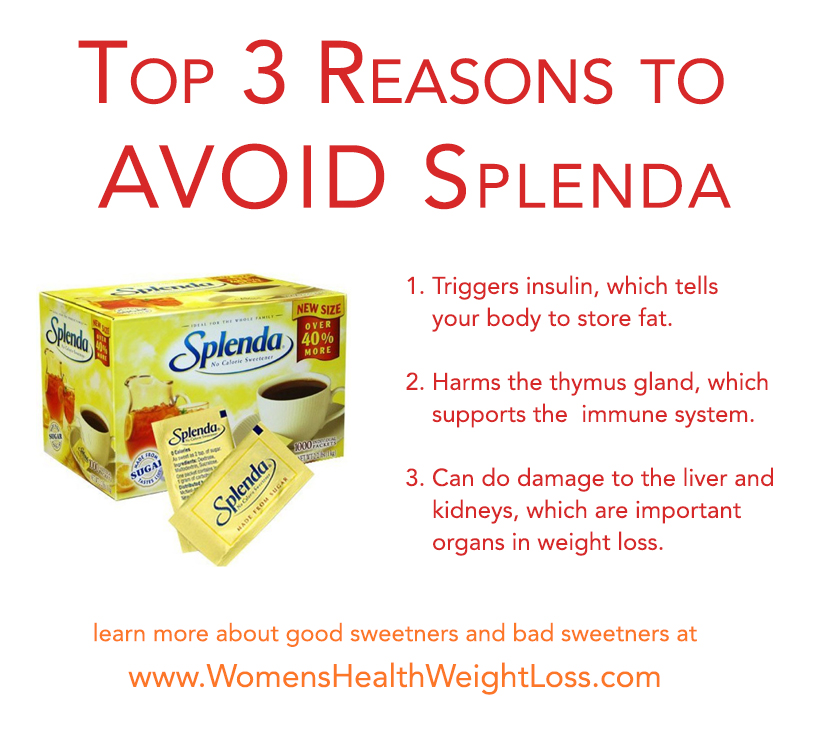Splenda & Weight Gain
The secret to Splenda's fantastic, non-fattening sweetness lies in the fact that it is not recognized by the body as a food substance. It quietly passes through your digestive track without depositing any caloric residue whatsoever.
Yet, despite its zero-calorie content, Splenda triggers an increase in insulin levels, which signal the body to hold on to fat reserves or to store even more fat on your beautiful body. So, the bottom line is ... yes, Splenda can make you fat.
Splenda Side Effects
|
Rashes |
Abdominal pain |
Anxiety |
Splenda Health Effects
Nutritionist Janet Starr Hull has researched Splenda and other new sugar substitutes and shares these conclusions:
- Splenda is a chlorocarbon, which has a history of producing organ impairment, genetic mutation and reproductive issues.
- Splenda can do damage to the thymus gland, which plays an significant role in healthy immune system function.
- Splenda can induce swelling of the liver and calcification of the kidneys.
- The studies cited by the manufacturers Splenda only report selective results and do not show an accurate assessment of the actual health impact of Splenda.
- The chlorine that is used in the process of producing Splenda is a carcinogen, a fact published in the OSHA Hazardous Waste Handbook.
- Sucralose is not as health-threatening as Aspartame. If you had to choose between the two, choose Splenda. Saccharin is the only artificial sweetener that is in any way acceptable. But you will be better off using a natural form of sweetener.
- The uncommon sweetness of sucralose (Splenda is rumored as being 600 times sweeter than sugar) only provokes greater addiction to the taste of sweetness.
- Unless one's digestion is impaired, any food or substance you ingest will be assimilated. If we feed the body a wholly indigestible material (such as margarine), it will move through the body undigested, if it doesn't get bound in the gall bladder. If sucralose is really indigestible, that is a bigger problem than the problem of absorption.
- The only benefit to using Splenda is the profit the manufacturer gains.

The Truth About Splenda
Splenda is a zero calorie sugar alternative in those little yellow packets that's been on the market for 10 years. Splenda is a man-made substance produced from a chemical composition that is created from the chlorination of normal sugar. Spleda is a sugar that has been chemically modified. Splenda has enjoyed a broad rise in popularity, and many people find it has less of an aftertaste than any other artificial sweetener.
The company that makes Splenda, McNeil Nutritionals, has repeatedly argued that Splenda has endured some of the most demanding food trials on record for any food additive. McNeil says that over 100 such studies have been conducted on Splenda. Most of these studies were done on animals, thereby casting doubt on the safety report for humans.ucted on Splenda. What they don't tell you is that most of the studies are on animals.
Splenda: A Natural Sweetener?
The chemical name of Splenda is sucralose. While sucralose begins as as a sugar molecule, it is the process by which it's made that is concerning. Sucralose is a synthetic chemical that is manufactured in a five-step patented process. During this process, three chlorine molecules are added to a sugar molecule. The initial, natural sugar molecule is a disaccharide made up of two single sugars bound together; these single sugars are glucose and fructose.
The chemical process used in making sucralose modifies the chemical makeup of the sugar so much that it is converted into a molecule that does not normally occur in nature. Because this artificial molecule is not natural, the body does not know how to metaboize it. According to the manufacturers of Splenda, this is the very grounds on which Splenda is calorie neutral -- it is not broken down or metabolized by the body. Splenda simply passes through your digestive track without depositing any caloric residue.
This is misleading, however, as Splenda's no calorie status would only hold up if the body did have the capability to metabolize it. More troubling, the fact that sucralose is a wholly artificial ingredient proves questions about its safety, especially if used in large amounts over a long period of time. There is the additional matter of insulin reaction. While research reports are still inconclusive, the medical research community widely theorises that Splenda elicits an increase in insulin levels, which, despite the calorie content, will signal the body to hold on to fat reserves or even store more fat.
Splenda Self-Test: How to Detect if Splenda is Harming You
The best way to detect if sucralose is impacting your health is to perform this simple test. First, eliminate sucralose entirely from your diet for two weeks (as well as all other artificial sweeteners). After two weeks, consume three to five portions of Splenda for up to three days. Do not eat any other variety of artificial sweetener during this time. Observe very carefully how your body responds. If you notice any of the symptoms listed above, there is reason to believe that you have a sucralose intolerance. If you have severe reactions, particularly on day one, there is a very hight chance that Splenda has a toxic effect in your body. It would be a good idea to avoid Splenda entirely. This self-test can be done with any of the artificial sweeteners.
